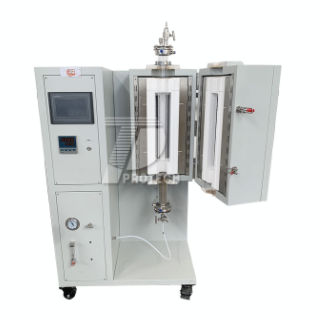


NEWS
Vertical tube furnace is a high-temperature heating equipment with a vertical structure, mainly composed of furnace shell, furnace tube, heating element, temperature control system, etc. The furnace tube is the core component of a vertical tube furnace, usually made of high-purity quartz glass or ceramic materials, which can withstand high temperatures and corrosion. Heating elements generally use resistance wires or electric heating tubes to heat the materials inside the furnace tubes through current. The temperature control system is responsible for monitoring and controlling the temperature inside the furnace, ensuring the accuracy and stability of the experiment.

A commonly used vertical fluidized bed tube furnace (click on the image to view product details)
Vertical tube furnace has many advantages, such as wide high-temperature range, uniform heating, precise temperature control, safety and reliability. At the same time, it can also achieve various process gas control and vacuum operation, suitable for various high-temperature treatment, heating experiments, fluidized beds, such as material preparation, chemical reactions, heat treatment, etc. Vertical tube furnaces can also be customized according to different needs, with flexible and diverse designs, widely used in universities, research institutes, industrial and mining enterprises and other fields.
1. The structure and working principle of a vertical tube furnace:
① Vertical structure: Vertical tube furnaces usually adopt a vertically arranged design, with a vertically placed pipeline inside the furnace chamber, in which heating elements and insulation layers are placed.
2. The main application areas of vertical tube furnaces are:
① Laboratory research: In scientific research institutions and laboratories, vertical tube furnaces are commonly used for various material properties research, laboratory experiments, and sample preparation.
② Heat treatment process: used for quenching, tempering, annealing and other heat treatment processes of metal and non-metal materials to improve the mechanical and structural properties of materials.
③ Fluidized bed: In drug preparation, for example, for drugs that are difficult to dissolve in water, some excipients with good fluidity, stability, compatibility, and low toxicity can be selected as the core, and fluidized bed technology can be used for microcapsule preparation Ceramic sintering: Suitable for the sintering process of ceramic materials, ensuring the density, hardness, and strength of ceramic products.
⑤ Experimental sample processing: Used for high-temperature treatment, sintering or annealing of experimental samples to simulate the performance of materials in practical applications.
⑥ Chemical product processing: In terms of chemistry, it can be used to prepare chemicals, catalysts, adsorbents, etc.
⑦ In terms of food: nutritional and health products, additives, seasoning, preparation of starch, protein, oil and other products, as well as being used in the field of waste residue treatment to treat sludge, solid waste, etc.
⑧ In terms of industry, vertical tube furnaces can also be applied in many fields such as power plant boilers, catalytic cracking, industrial boilers, cellar furnaces, waste incineration, cement industry, powder processing, particle drying, polycrystalline silicon preparation, physical and chemical vapor deposition, and production and processing of micro and nano materials.
3. What are the characteristics and advantages of vertical tube furnaces:
① Space saving: The vertical design of a vertical tube furnace can save space and is suitable for situations with limited space or the need for multiple furnaces.
Leave A Message